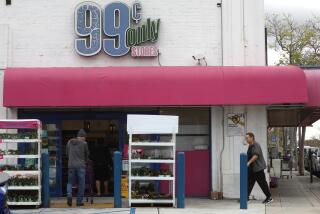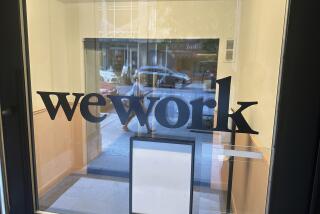Phil Hawley’s Last Chapter : Retailing: Some doubt he has the time and opportunity to turn Carter Hawley Hale around. But he is confident of the course the company will take with Zell/Chilmark.
- Share via
At an age when many corporate titans are enjoying retirement, Philip M. Hawley is out there in the workaday grind trying to prove himself.
Still.
The 66-year-old chairman and chief executive of Carter Hawley Hale Stores, whose youthful appearance and Charlton Heston-like good looks belie his age, helped build the nation’s sixth-largest retailing chain.
But Hawley saw his empire begin to fade about 15 years ago. By the mid-1980s, the weakened chain was the target of two brutal takeover drives that--though foiled--left the former powerhouse so troubled that it slipped into bankruptcy earlier this year.
Now, with the bankruptcy proceedings set for completion early next year, Hawley has one last chance to erase his image in industry circles as the executive who blew his secure heritage in the retail heaven known as California. And he’s fighting to grab it.
“He knows in his heart of hearts that he screwed up,” says David Schulte, half of the Chicago investment partnership Zell/Chilmark, which will take control of the company when it emerges from bankruptcy. “He’s 66 years old, and he wants to go out on a high note. He feels that down deep. . . . He’s heard the bell ring.”
These days Hawley is focused on what he calls his “final chapter”: the company’s emergence from bankruptcy and a $100-million modernization of its outdated and shop-worn outlets, many of which haven’t been remodeled for two or three decades.
These changes, he believes, will bring his vindication.
“It’s very fashionable to dump on this company and its management. That’s to be expected, and it’s OK,” Hawley said in his first extensive interview since striking a deal with Zell/Chilmark. “The final chapter is still out there yet to be written.”
Many, however, question whether Hawley has the time or the opportunity to return Carter Hawley Hale, whose stores include Broadway and Emporium, to its former glory.
For starters, department stores are less fashionable than they used to be with shoppers. Throughout the country, they continue to lose their share of the consumer’s dollar to specialty stores, such as Gap, Victoria’s Secret and Circuit City, and discount outlets such as Price Club, Target and Wal-Mart.
In addition, Hawley’s post-bankruptcy partners--two so-called vulture capitalists who are set to take majority control of the company when it emerges from bankruptcy--may not offer him the chance to do all that is still on his private agenda.
The focus of Hawley’s new partners, analysts say, is to turn a profit from their investment, a goal that could lead them to favor selling off the chain’s prime mall real estate rather than face the mounting hassles of operating in a less friendly retailing environment.
As a result, analysts say, Hawley could find it difficult to burnish his image.
“Phil Hawley will go down in retailing’s ‘Hall of Shame,’ ” says Alan Millstein, a New York retailing analyst and newsletter publisher. “His legacy will be that he fought off a $60-per-share buyout offer by selling the company’s best assets and getting his employees to invest their pension money in the company’s stock. Now the company is in bankruptcy, and those shares are worth less than $2 each. It was truly one of the big bloopers of the 1980s.”
Hawley, whose perennial optimism is legendary in retailing circles, refuses to publicly second-guess his responses to the two hostile takeover attempts launched by Limited Chairman Leslie Wexner in the 1980s. Hawley still believes that he was right to fight off Wexner’s first takeover in 1984, then reject his even sweeter $60-per-share offer for Carter Hawley in 1986.
The price of holding Wexner off, however, was steep. Hawley was forced to sell off huge pieces of the empire, including what had been considered the chain’s crown jewels: the Bergdorf Goodman and Neiman-Marcus outlets. Then he put his employees’ retirement savings into company stock, so it would be in friendly hands.
“I still don’t think that I should have taken Wexner’s offer, and it’s OK that I didn’t,” Hawley says. “I don’t spend a lot of time looking back. I look forward. The company has major value growth opportunities ahead.”
When the company emerges from bankruptcy within the next six months, controlling ownership of Carter Hawley Hale stores will pass to Samuel Zell and Schulte. They bought the retailer’s debt for 47 cents on the dollar and pledged to forgive it in exchange for a majority of the company’s equity.
The exact amount of equity given to Zell and Schulte will depend on negotiations among current shareholders, the company and the Chicago investors, and must be approved by the U.S. Bankruptcy Court before the company can leave Chapter 11.
Hawley, the largest shareholder, not only supports the deal, but he helped bring it together, trading on his longtime friendship with Zell, a street-wise Chicago real estate investor, and their nearly two decades of real estate-related deal making.
Some industry analysts suspect that Zell and Schulte are interested in the retailer only for the liquidation value of its superb real estate holdings in California malls, including the Beverly Center and Century City. The chain also owns valuable real estate in downtown San Francisco that analysts speculate could be converted to more profitable office or commercial space during the next decade.
“Remember, Sam Zell is a real estate guy, not a retailer,” says a Midwest analyst who requested anonymity. “You cannot lose sight of that fact.”
Analysts also say there is a strong chance that Zell and Schulte might push Hawley into retirement as soon as the company attains a post-bankruptcy stability with its suppliers and employees.
Zell and Schulte maintain that they have “absolutely no plans” to sell big chunks of the company or to force out Hawley.
“The guillotine isn’t going to hit Phil Hawley’s neck,” Schulte says. “It doesn’t have to. We want the same things. We have a common purpose and a mutual respect.”
For the time being, Hawley will keep his titles as chairman and chief executive. But his job, which he hopes to hold for the next four or five years, will largely be reduced to executing the turnaround plan fashioned and financed by Zell and Schulte.
Analysts say they believe that Hawley genuinely sees Zell and Schulte as saviors of his company and is willing to sacrifice his control and position to salvage what he can of an empire than once included some of the premier names in American retailing.
Carter Hawley Hale, which traces its lineage to the Los Angeles of 1896, operates the oldest department store chains in California: Weinstocks, Emporium-Capwells and Broadway.
In 1950, Broadway Stores, then run by Edward Carter, merged with Hale Bros., the owner of Weinstocks, then operated by Prentis Cobb Hale. Hawley joined the company in 1958, by then named Broadway-Hale stores, as a sportswear buyer in the Broadway division. He quickly climbed the executive ladder to become the unit’s president in 1968.
Meanwhile, Broadway-Hale had been buying the Emporium and Capwell stores in the San Francisco area and completed the purchase in 1970. In 1972, Hawley was named president of the Broadway-Hale family of stores, and two years later the company’s name was changed to Carter Hawley Hale Stores.
Under Hawley’s leadership, the company dramatically expanded its holdings in the 1970s to include some of the best-known names in American retailing: Neiman-Marcus, Bergdorf Goodman, John Wannamaker, Thalhimers and Waldenbooks. But the company, then the nation’s sixth-largest retailer, was beset with operational problems that dragged down profit and made it an attractive takeover target.
The cost of the defense against the Wexner takeover attempt was the sale of all but the company’s original three chains.
Now, Hawley and Schulte acknowledge that the company will sell or close up to 10 of its 88 remaining stores when it emerges from bankruptcy next year. The locations of the units will be released in about three months, when the company unveils its bankruptcy reorganization plan and advises its mall landlords of its intentions.
With some exceptions, notably such new outlets as the Broadway in South Coast Plaza and the post-earthquake-refurbished Emporium in downtown Oakland, the remaining stores will be thoroughly remodeled and modernized at a total cost of more than $100 million over the next several years. Zell and Schulte have pledged a $50-million loan for the remodeling, and more is expected.
Hawley, who owns more than 1.3 million shares in the company, clearly believes that the deal with Zell is in the best interests of shareholders--particularly his employees, who proved their loyalty in 1987 by buying nearly 45% of the company’s outstanding shares. Because of sales of operating units and store closings, which have thinned employee ranks considerably, Carter Hawley workers now control about 35% of the shares.
“In most Chapter 11 bankruptcies, the equity gets eliminated,” says Hawley, whose own shares of company stock have plunged in value along with those of his employees. “But we’ve structured something here where the equity is kept alive and has the opportunity to grow. . . . Zell/Chilmark sees this company as a modernization play. Shouldn’t the employees get the same opportunity as Zell/Chilmark?”
Few analysts doubt that Zell/Chilmark will make money from its investment in Carter Hawley Hale. The fund has committed to purchase about 80% of the company’s nearly $580 million in outstanding trade debts and junk bonds for about $226 million. In exchange for forgiving those debts, Zell and Schulte are expected to get more than 50% of Carter Hawley’s common stock.
But analysts question whether the employees or any other longstanding Carter Hawley shareholder will do as well.
“If tar and feathering were legal, the long-term employees of Carter Hawley Hale would do that to Phil Hawley,” says William Fiore, head of Local 1100 of the Department Store Employees Union in San Francisco and a former Emporium furniture salesman. Fiore paid an average of $15 each for his employee shares of the company more than a decade ago. He has seen those shares dwindle in value to about $2 each.
“They (employees) feel out-and-out cheated,” he said. “And unless Zell/Chilmark turns this company around dramatically, they will be.”
For his part, Hawley believes that he is already making good on his start to the final chapter. Since filing for bankruptcy Feb. 11, the company has found investors with deep pockets, embarked on an ambitious modernization plan and set itself on a course to emerge from bankruptcy by the middle of next year.
“Say what you will about what went on before bankruptcy,” says Bill Donbrowski, Hawley’s chief public relations lieutenant. “But since Feb. 11, Phil has done everything right.”
Bio: Philip M. Hawley
Chairman of Carter Hawley Hale Stores
* Age: 66
* Born: Portland, Ore.
* Education: Received B.S. degree in business from UC Berkeley in 1946, earning Phi Beta Kappa honors.
* Family: Married to the former Mary Follen. The couple has eight grown children and 11 grandchildren.
* Resume: Hawley joined the Broadway division of the former Broadway-Hale Stores in 1958 as a sportswear buyer. He became president of the division in 1968 and in 1972 was named president of the parent corporation, Broadway-Hale Stores. His name was added to the chain’s name in 1974, when it became known as Carter Hawley Hale Stores. He became chief executive in 1977 and in 1983 took on the additional title and responsibilities of chairman.
* Business philosophy: “This will be the last period I’m working with the company. Now we want to take the stores that are in bad shape and turn them around. . . . We are in desperate need of a new look in the stores.”
* Quote: “We run too many sales. Department stores are promotion crazy. When you create the right environment and offer the right merchandise, people will buy.”
More to Read
Inside the business of entertainment
The Wide Shot brings you news, analysis and insights on everything from streaming wars to production — and what it all means for the future.
You may occasionally receive promotional content from the Los Angeles Times.










